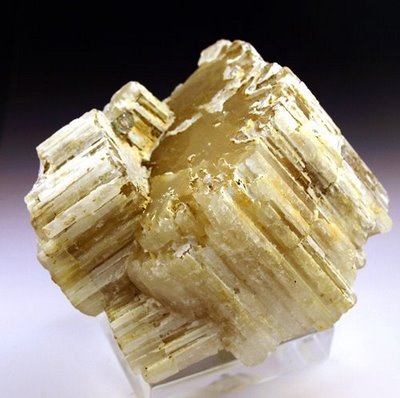| Crystal system | Monoclinic with pseudo-othorhombic system |
| Transparency | Transparent |
| Luster | Vitreous |
| Fracture | Conchoidal |
| Cleavage | Perfect; good pinacoidal |
| Specific Gravity | 2.85 |
| Hardness | 5.5 to 6 |
| Optical Character | Biaxial - ; Double Refractive |
| Refractive index | 1.552-1.562 |
| Birefringence | 0.010 |
| Dispersion | 0.010 |
| Fluorescence | |
| Pleochroism | None |
| Chemical Formula | NaBePO4 |
| Comments | Attacked by acids |
| Streak | White |
Because beryllonite (bare-ILL-oh-nite) has a low degree of brilliancy, is soft, and is always colorless or light yellow, it has little application as a jewelry stone. However, since the mineral is often transparent and is sufficiently hard to be cut and polished, specimens are occasionally seen in museums and private collections.
The only area from which gem-quality material has come is the Stoneham and Newry, Maine, region. There it occurs in veins in granite with beryl and phenakite, the result of magmatic solutions.
Beryllonite belongs to the monoclinic crystal system and occurs in complex, often twinned, crystals with pseudo-orthorhombic symmetry. Its chemical composition is sodium-beryllium phosphate, expressed by the formula NaBePO4. It has a hardness of 5 1/2 to 6, poor toughness (because of perfect cleavage), a conchoidal fracture, a specific gravity of approximately 2.85, and a white streak. There are no characteristic inclusions. The luster is vitreous but may be slightly pearly. The R.I. is 1.552 - 1.542, with a consequent birefringence of .010. No phenomenon is shown. It is attacked by acids and fuses before the jeweler's torch or the blowpipe.
Stones may be faceted or cut in the cabochon style. Although cleavage sometimes causes difficulty, it is not heat sensitive to the temperatures generated by any of the steps in the fashioning process. Some caution should be exercised in the grinding operation, however, since beryllonite grinds away more rapidly in some directions than in others, indicating a possible hardness variation with direction. Polishing is accomplished satisfactorily on a tin lap with Linde A powder. An alternate method is to use cerium oxide on a lucite lap. Care must be used when polishing on lucite, however, since it generates heat rapidly. Crown angles of 42° and pavilion angles of 43° prove effective for this gem.
Beryllonite is often confused in testing with both quartz and beryl, but it can be distinguished by its optic sign and higher S.G. Actually, the R.I. is between the figures for quartz and beryl, and the birefringence is slightly greater than either; however, this is so close as to be of little value.


